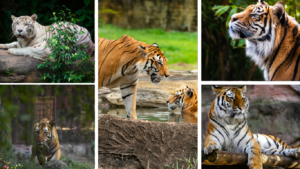TOP 10 TIGER RESERVE OF THE WORLD
The magnificent tiger, respected for its power, beauty, and cultural importance, roams the lush forests and verdant landscapes of some of the most stunning natural reserves on the planet. Tigers, as apex predators, play an important part in preserving environmental equilibrium. They confront a variety of problems, including habitat degradation, poaching, and human-wildlife conflict.
Tiger reserves have been built all around the world to protect these wonderful species and their natural habitats. These reserves act as sanctuaries for tigers, allowing them to wander freely while prioritizing conservation efforts for their survival. Join us on a thrilling tour across the top ten tiger reserves, which serve as beacons of hope for the survival of these renowned great cats.
 1. Hukaung Valley Tiger Reserve in Myanmar In the heart of northern Myanmar, the Hukaung Valley Tiger Reserve is a beacon of hope for tiger conservation and ecological preservation. Its secluded environment, filled with unique flora and animals, provides a window into a world unaffected by technology. As attempts to safeguard and restore this valuable ecosystem continue, Hukaung Valley serves as a reminder of nature’s eternal beauty and perseverance in the face of hardship. For those who dare to delve into its untamed depths, the rewards are limitless – a voyage of discovery and amazement through one of the world’s few real wilderness areas.
1. Hukaung Valley Tiger Reserve in Myanmar In the heart of northern Myanmar, the Hukaung Valley Tiger Reserve is a beacon of hope for tiger conservation and ecological preservation. Its secluded environment, filled with unique flora and animals, provides a window into a world unaffected by technology. As attempts to safeguard and restore this valuable ecosystem continue, Hukaung Valley serves as a reminder of nature’s eternal beauty and perseverance in the face of hardship. For those who dare to delve into its untamed depths, the rewards are limitless – a voyage of discovery and amazement through one of the world’s few real wilderness areas.
2. Ranthambore Tiger Reserve, India Ranthambore Tiger Reserve, located in the heart of Rajasthan, invites explorers and nature enthusiasts to go on a trip into the wild, where India’s rich cultural past blends with the majesty of its natural treasures. Whether gazing at a Bengal tiger stalking through the forest or touring the historic remains of Ranthambore Fort, visitors to this renowned reserve will be charmed by its beauty, diversity, and conservation spirit. The tiger reserve is around 160 kilometers from Jaipur, Rajasthan. The most convenient method to get to the park is by rail to Sawai Madhopur Railway Station, which is connected to Jaipur, Mumbai, and Delhi.
3.Sikhote-Alin Nature Reserve, Russia
Sikhote-Alin Nature Reserve exemplifies the untamed beauty and ecological relevance of Russia’s far eastern wildness. Whether you’re pulled to the attraction of rare wildlife encounters, entranced by the stunning landscape, or inspired by the spirit of conservation, a visit to this remarkable refuge offers an amazing journey into the heart of nature’s marvels.Sikhote-Alin Nature Reserve, located in Russia’s far east, is a pristine wilderness abounding with biodiversity and natural treasures. This protected region, which covers more than 4,000 square kilometers, is a paradise for animal aficionados, adventurers, and conservationists alike. Let’s take a virtual tour of this incredible refuge and find its hidden beauties.
4.Durminskoye Reserve of Siberia
The Durminskoye Reserve, tucked among Siberia’s immense wildness, exemplifies Russia’s dedication to protecting its natural heritage. This beautiful sanctuary, located in the Irkutsk area, comprises a variety of ecosystems, ranging from thick taiga woods to broad wetlands, offering essential homes for a diverse range of wildlife.
The Durminskoye Reserve, established in 1986, is one of Siberia’s largest protected areas, covering approximately 270,000 hectares. Its major goal is biodiversity conservation, with a special emphasis on preserving the region’s iconic animals, such as the Siberian tiger, the world’s biggest feline predator.
5. Kerinci Seblat National Park, Indonesia
Kerinci Seblat National Park. This immense swath of wildness, covering over 13,000 square kilometers, is not only Indonesia’s largest national park, but also one of the most biodiverse locations on the planet. Kerinci Seblat, with its lush jungles and towering volcanic peaks, provides an unparalleled view of Indonesia’s natural treasures.
Kerinci Seblat National Park is more than simply a protected area; it exemplifies Indonesia’s rich biodiversity and cultural history. By protecting this natural treasure for future generations, we not only assure the survival of innumerable species, but also guarantee that future visitors will be astounded by Kerinci Seblat’s wild beauty.
6.Chitwan National Park,Nepal
Chitwan National Park, located in southern Nepal’s Terai lowlands, is a natural beauty and wildlife refuge. Established in 1973 and declared a UNESCO World Heritage Site in 1984, this wide area of wilderness covers 932 square kilometers, making it one of Nepal’s most treasured conservation areas and a popular destination for animal enthusiasts and environment lovers.
Chitwan National Park provides a stunning combination of natural beauty, wildlife encounters, and cultural experiences that are sure to captivate the hearts and minds of adventurous tourists looking for a real jungle safari experience in Nepal’s wildness.Chitwan National Park provides a captivating combination of natural beauty, wildlife encounters, and cultural experiences that are sure to captivate the hearts.
7. Tiger Kingdom Chiang Mai, Thailand
In the lush greenery of northern Thailand, there is a sanctuary that provides visitors with a unique and amazing opportunity to get up close and personal with one of nature’s most spectacular creatures, the tiger. Welcome to Tiger Kingdom Chiang Mai, an immersive wildlife experience that will captivate the hearts and minds of both animal enthusiasts and adventure seekers.
Tiger Kingdom Chiang Mai provides a once-in-a-lifetime opportunity to witness the beauty and grandeur of tigers up close while also raising awareness and protection of these amazing species. Whether you’re looking for adventure, education, or just a deeper connection with nature, a visit to Tiger Kingdom Chiang Mai is guaranteed to create an impact and spark a love for animal conservation.
8. Sundarbans National Park, Bangladesh
The Sundarbans National Park, located in the delta of the Ganges, Brahmaputra, and Meghna rivers, exemplifies nature’s raw majesty. This UNESCO World Heritage Site, located primarily in Bangladesh but also extending into India, is known for its abundant biodiversity, unique environment, and the elusive Royal Bengal Tiger.
Sundarbans National Park exemplifies nature’s resilience and the ongoing relationship between humanity and the environment. As we work to preserve this natural wonder for future generations, let us appreciate its beauty, embrace its secrets, and walk softly on its holy grounds. Welcome to the enchanted world of the Sundarbans, where each moment is a discovery and every interaction is a celebration of life.
9..Northeast Tiger Leopard National Park (NTLNP), China
The Northeast Tiger Leopard National Park (NTLNP) is a genuine paradise for wildlife fans and environmentalists alike, nestled among China’s magnificent landscapes in the northeast. This huge park, which spans the provinces of Jilin and Heilongjiang, is not only a shelter for the rare Amur tigers and leopards, but it also has a rich tapestry of wildlife and cultural legacy. A visit to the Northeast Tiger Leopard National Park provides a unique opportunity to observe the beauty of China’s untamed landscapes while also encountering some of the world’s most elusive predators in their native environment. Whether you’re a wildlife enthusiast, an adventure seeker, or simply a nature lover, this magnificent national park guarantees an amazing experience that will leave an indelible stamp on your heart and mind.
10. Royal Manas National Park, Bhutan
Bhutan’s majestic Royal Manas National Park is located in the heart of the Eastern Himalayas, where virgin forests meet steep mountains. This biodiverse refuge, which spans over 1,000 square miles, is not only Bhutan’s oldest national park but also a UNESCO World Heritage Site, recognized for its rich biodiversity and cultural importance.
Royal Manas National Park serves as a symbol of hope for global conservation efforts, showcasing the peaceful coexistence of humans and the environment. Let us also consider the necessity of safeguarding and conserving our planet’s priceless natural resources. A visit to Royal Manas National Park is more than simply a voyage into the wilderness; it’s a celebration of humanity’s deep connection with the natural world.

